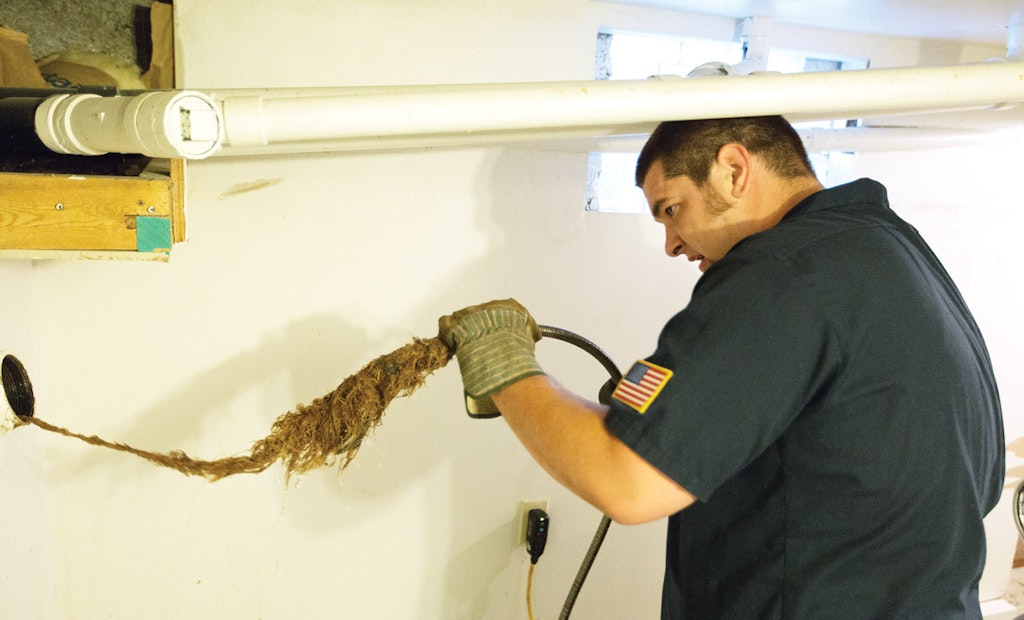
Interested in Cleaning?
Get Cleaning articles, news and videos right in your inbox! Sign up now.
Cleaning + Get AlertsCleaning a residential sewer line with roots can be a challenge. If you have traditional drain cleaning equipment and a jetter you have many advantages over companies who only have one or the other.
Dealing with customers
There is a process to follow when dealing with a homeowner regarding roots. Odds are that you’ve already charged them to open the drain and run a camera down the line. Convincing a homeowner to tack on extra charges on top of that can be difficult. Showing the customer the extent of the root intrusions is a big help — seeing is believing.
It is tough to give an accurate answer as to how long it may take to get the roots out. It is also difficult to explain that the roots might not all be removed, and they will most definitely grow back at some point (on an unknown time scale).
Give the customer options and let them choose; you are not in control of their family bank account. Giving a thorough explanation of the root cutting process is of the utmost importance.
When to dig and when to cut
Effectively cutting roots starts with identifying what kind of roots you are dealing with. You don’t need to be an arborist and know exact root strengths, but you should be able to get a good idea of what you’re dealing with by looking at the sewer camera images. You’re not only looking for how thick they are but how long they’ve been growing in there.
Some of the hardest roots to get through are the thin fibrous root systems that have been growing for a long time. It’s like trying to cut a wet T-shirt. It’s a mat of millions of tiny roots that grow with the sewage and appears to have lined the flow line of the pipe. In most cases this type of root system will accumulate tons of black sludge. When you put the camera down the drain you may run into a soft feeling clog that just goes black. This is a good sign that these are the type of root intrusion you’re dealing with. If you see this it may be beneficial to just go straight to a dig up. If you can see the roots however, you can begin trying to punch a hole in them and go from there.
The cutting process
Depending on what equipment you have at your disposal, there are two different ways of attacking roots. Regardless of the equipment you have, the first step is to punch a hole in the roots so that the drain will take water. Once you get the drain to take water you can work effectively without having massive quantities of water backing up into the house.
If you only have access to a traditional rod machine, make sure you have a variety of tips that work to cut roots. There are many great options across the manufacturer spectrum. My go-to machine for roots at our shop is the RIDGID K-1500 with the root cutter tip, but there are many options across all platforms.
The tough part about using a traditional drain machine is that you must completely remove the camera before you start rodding, so you don’t damage the camera reel. If you are using this option, make sure you set the camera distance counter to zero while entering the drain. When you get to the roots make a note of how far out into the system they are. Say, for example, the roots are 30 feet from your access point. When you put your drain cables in run them to just shy of 30 feet. Run the machine into the line a few inches until you feel the tip catch the roots. Tear the roots a few inches at a time running the machine in forward for a few minutes, and then backward for a few minutes and then continue in a few more inches. Follow this process in and out until it starts to feel easier and you think you’ve done the job. Make sure you run water in a nearby sink while you are cutting roots to help wash the roots that you’ve cut down the drain.
If you have a powerful jetter, this process becomes much easier. After you punch through the roots and get water flowing, switch tips to whatever root-cutting tip you use. Push the tip in beyond the point of roots and follow that up by putting your sewer camera in behind it until you can see the roots. Now pull the root-cutting tip back until you can see it is in the correct position to eat roots. Pull the camera back far enough where it will be unaffected by the cutting tip and cut roots. Turn the water off and push the camera downstream and see your progress as needed.
If you have both traditional cable machines and a jetter you could use both on the same line as needed depending on how things are going. Grip and rip with the cables and cut things back with the jetter.





